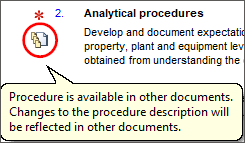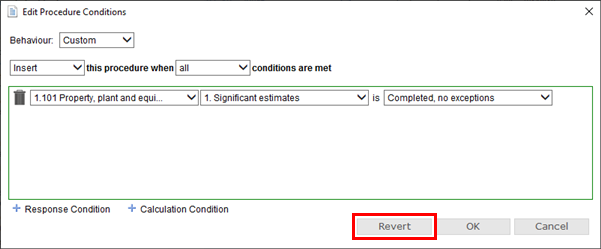What's new - Audit 21.00
The following describes the features and fixes for Audit 21.00.
For more information on content updates made to Audit International 21.00, see Audit International 21.00 Content Updates.
Features
Assertions
We’ve introduced the ability for distributors and firms to define how assertions are combined. Previously, template authors had to either accept the combined assertions defined by their content provider, or manually modify and take ownership of individual procedures to display the appropriate combined assertion. Now, template authors can define combined assertions according to their firm standards.
The following identifies the new functionality included for Assertions.
-
A new Assertions tab has been added to the AO - General options document. Now, you can update all assertion settings under the Assertions tab instead of the Work Programs tab. The existing option to define the number of assertions has been renamed from Number of assertions to Number of combined assertions.

-
In the Assertions tab, you can define how assertions are combined by clicking the Associate base assertions icon.

When modifying your combined assertions settings, a prompt will display to confirm your changes. Once confirmed, your procedures will automatically update to store the applicable base assertions. You can revert your changes back to the default setup by selecting N/A for all options.
-
In the AO - General options document, you have the option to include or exclude specific combined assertions from your template. If you exclude an assertion, it will be removed automatically from all work programs, Financial Statement Areas, risks, and controls.

-
The assertions Abbreviation character limit has been increased from 2 to 4.
-
When using the new assertion system in your template, procedures are automatically adjusted to reflect the new combined assertions that are associated to the assertions. Your Risks and Controls will also automatically be associated with equivalent combined assertions.
-
When opening the Financial Statement Areas (FSA) worksheet after updating your assertion settings in an engagement file, you will receive a warning that indicates that your assertion settings have been modified and assertions enabled on FSAs should be reviewed.
Note: Assertions in the FSA worksheet are not updated automatically in case engagement teams have modified the assertions during planning.
Common Procedures
We’ve introduced Common Procedures in work programs and checklists to help template authors become more efficient. Currently, template authors must re-author procedures that are required in multiple documents. Common Procedures enable template authors to create a single procedure that they can reuse in multiple documents.
The following identifies the new functionality included for Common Procedures.
-
You can now save a new procedure, or designate an existing procedure as a common procedure in the Procedure Properties. Reuse common procedures in other work programs or checklists to save time authoring content. Select Procedure is available in other work programs in a work program, or Procedure is available in other checklists in a checklist.

-
Modifications to a common procedure are automatically pushed to all other documents containing the procedure. Template authors only need to edit the procedure once; all instances will automatically update the next time the document is opened.
-
In template mode, icons have been added next to common procedures to indicate that changes to those procedures will affect other documents.

-
When inserting procedures from the Content Library, there is now a Common column to help you identify common procedures.

-
You can designate the availability of common procedures on a per-document basis from Author | Set Procedure Availability. If common procedures are not relevant, you can revoke the availability of the procedures to prevent them from being inserted incorrectly.
-
Added a warning message that prevents authors from overwriting or deleting common procedures that are being, or have been, modified by another template author in another document. If the common procedure being modified is outdated, you will be prompted to insert the updated procedure before making any further changes.
-
Deleting a common procedure from the Content Library of one document will automatically remove all instances of the same procedure in other documents.
-
Common procedures support unique positioning in individual work programs and checklists. You can position the same common procedure differently in individual documents and the ordering will be retained even after content updates; however, common procedures can not have different groups or subgroups.
-
When editing a common procedure’s conditions, you can choose to apply the conditions globally across all instances of the common procedure, or at the document level.

When you apply unique conditions to a common procedure at the document level, the procedure condition icon will display a red dot (
 ).
). -
Added the option to revert unique conditions in a common procedure back to the globally defined condition set.

-
Firm authors can take ownership of a distributor’s common procedure. When ownership is transferred, the distributor’s common procedure is disabled and a firm copy of the common procedure is created. All instances of the distributor’s common procedure in other documents is automatically replaced with the firm’s common procedure.

-
Performing a content update on a work program or checklist now checks for changes to common procedures. Required common procedures are automatically inserted into the document, and existing common procedures that were modified or deleted are updated in the document.
-
Common procedures support individual risk, control and reportable item linkages. Linkages are unique to the instance of the common procedure where they were added.
Fixes
-
Fixed an issue that prevented users from viewing the Risk Report when the engagement file is locked down.
-
Fixed an issue where the Comments column under Adjusted performance materiality levels would be skipped when printing the 420 - Materiality document.
-
Fixed an issue where automatic document updates were applied even though the update process was cancelled.
This online help system applies to all CaseWare Audit, Review, and Compilation products. Not all features are available in all products.




